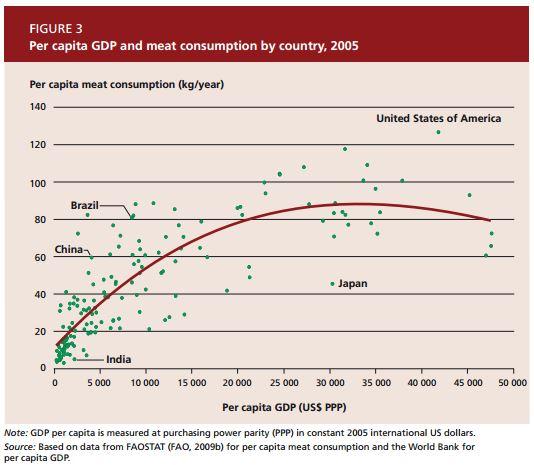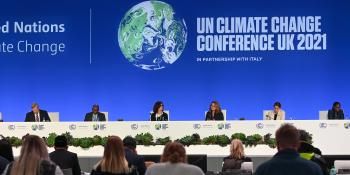Meat and milk to feed a growing population

A review of what researchers have learned about livestock and the environment helps to set an agenda for moving from knowledge to action.
The world’s growing population is constantly demanding higher levels of livestock products—meat, milk, and eggs—to satisfy an increasing appetite. As people become wealthier, they tend to eat more animal products, and researchers have dubbed the rapidly growing demand for meat and milk the Livestock Revolution.
As per capita GDP increases, so does the consumption of meat. Source: The State of Food and Agriculture. Livestock in the balance (2009), FAO.
Environmental costs of raising livestock
When it comes to climate change, livestock contribute to the problem and are also affected by it
The raising of livestock and the eating of animal products has social, cultural, and economic benefits, but also come at a cost to the environment. Livestock are produced in many ways. A pastoralist in Ethiopia might have a mixed herd of cattle, sheep, and goats grazing across a wide swath of semi-arid land, a smallholder farmer in Vietnam might have some pigs and chickens integrated with her crops, or a major corporation might have an intensive meat production factory in the United States. Around the world, in all of these systems combined, raising livestock accounts for about 80% of all agricultural land and 25-32% of agricultural water use.
When it comes to climate change, livestock contribute to the problem and are also affected by it. An estimated 8-18% of human-caused greenhouse gas (GHG) emissions come from livestock. And as the climate shifts and average temperatures continue to rise, animals will suffer from heat stress, more parasites and diseases, and reduced quality and availability of feed.
A recent review paper, led by the Commonwealth Scientific and Industrial Research Organisation (CSIRO) in collaboration with the CGIAR Research Program on Climate Change, Agriculture and Food Security (CCAFS) and partners, documents these environmental impacts of livestock and also summarizes what we know about how to deal with them. Some of the techniques that scientists already know will help reduce GHG emissions from livestock include more digestible feed, better manure management, and avoiding deforestation by raising livestock in a more intense but sustainable manner.
Watch the video for a short summary of the paper:
Moving from knowledge to action
While the research over the past decade has been critical in measuring livestock’s environmental impacts and the potential mitigation benefits of different management practices, the time is now ripe for moving from knowledge to action. The authors call for a new research agenda that can examine how best to spur large-scale adoption of key practices. Central to this is getting the policy environment and the incentives right, on both the supply and the demand side. From a supply point of view, subsidies and taxes can both be used to help reduce land use changes and curb emissions, but we need more documented case studies to see how these strategies are working in practice, and how they affect farmers’ livelihoods and food and nutritional security.
On the demand side, wealthy countries can use different policies to try to reduce meat consumption where it is excessive. Changing dietary patterns in high meat-consuming populations in both developed and developing countries theoretically holds potential for reducing environmental impacts, but these changes are only hypothetical so far. Whether consumer preferences can be changed through policies, such as with consumption-based taxes, has yet to be seen. Shifting the research agenda to investigate these issues and others outlined in the paper can give policymakers a better understanding of how to make improvements on large scales and make livestock production better for the environment. It could also help us learn more about how to promote healthy and sustainable diets for more people, which may involve increasing consumption of animal products for some (for example, people in poorer households who would benefit from more protein) and reducing consumption among others.
What do you think? Can we make positive changes using improved policies? Would a tax help reduce meat consumption in your country? Are social movements like Meat Free Monday having an impact on you or anyone you know?
Download the paper: Herrero M, Wirsenius S, Henderson B, Rigolot C, Thornton P, Havlík P, de Boer I, Gerber P. 2015. Livestock and the environment: What have we learned in the past decade? Annual Review of Environment and Resources 40:177-202.
Laura Cramer is a consultant with the CCAFS flagship on Policies and Institutions.




